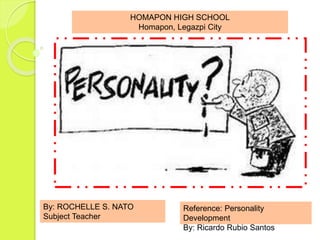
Personality
- 1. HOMAPON HIGH SCHOOL Homapon, Legazpi City By: ROCHELLE S. NATO Subject Teacher Reference: Personality Development By: Ricardo Rubio Santos
- 2. Objectives 1.Define the word Personality 2.Discuss the Nature, Nurture and Personality 3.Elaborate and Evaluate your own personality.
- 3. Personality – is referred to as set of behaviors, feelings, thoughts and motives that identifies an individual.
- 4. Personality - is the essence of who we are and is the embodiment of one’s physical, psychological, cognitive, affective and spiritual self.
- 5. Viewpoints of Personality Psychologist about Personality Personality refers to the unique and relatively enduring set of; 1. Behaviors 2. Feelings 3. Thoughts 4. Motives that characterize an individual. ( Feist and Rosenberg)
- 6. 2 key components of Personality 1.Uniqueness 2.Relatively enduring (being consistent)
- 7. Gordon Allport Personality- as a “pattern of habits, attitudes and traits that determine an individual’s characteristics, behavior and traits.. Gordon Allport, in full Gordon Willard Allport (born November 11, 1897, Montezuma, Indiana, U.S.—died October 9, 1967, Cambridge, Massachusetts), American psychologist and educator who developed an original theory of personality.
- 8. Nature, Nurture and Personality Personality is influenced by NATURE (heredity or genetic make- up) NURTURE (environment)
- 9. One general point of view explains that personality deals with traits, wherein it is major factor in personality. Trait Theory- is an approach in identifying types of personalities based on certain traits or attributes, which may vary from one person to the other.
- 11. BIG FIVE Low Scores High Scores 1. Extroversion Loner Quiet Passive Reserved Joiner Talkative Affectionate Active 2. Agreeableness Suspicious Critical Ruthless Irritable Trusting Lenient Soft-hearted Good-natured 3. Conscientiousness Negligent Lazy Disorganized Late Conscientious Hard-working Well-organized Punctual 4. Neuroticism Calm Even-tempered Comfortable Unemotional Worried Temperemental Sel-conscious emotional 5. Openness to experience Down to earth uncreative Imaginative Creative
- 12. Paul T. Costa, Robert R. McCrae Psychologist and developed a categorized scheme that described personality. Based on their researched, they discovered the existence of five universal and widely agreed upon dimensions of personality. They called it the Big Five or Five-Factor
- 13. These dimensions or tendencies are; O C E A N Openness to experience Conscientiousness Extraversion Agreeableness Neuroticism
- 14. Openness to experience Curiosity, interest, imagination, and creativity to new ideas Conscientiousness Planning organizing, hard- working, controlling, persevering and punctuality
- 15. Extraversion Sociable, Talkative, active, outgoing, and fun-loving Agreeableness Friendly, warm, trusting, generous and kind-hearted Neuroticism Calm, relaxed, and comfortable
- 16. What is the difference between Personality and Personality Trait?
- 17. Personality Trait – is a disposition to behave consistently in a particular way while Personality is a broader term that comprises of traits, motives, thoughts, self-concept and feelings Ex. Shyness or social awkwardness.
- 18. How to measure your personality?
- 19. Personality can be measured using different kinds of tests 1. Rorschach Inkblot Test 2. Myers-Briggs type indicator (MBTI) 3. Keirsey Temperament Sorter. Isabel Brigs Myers and Katherine Briggs personality model based on four preferences of individuals 1.E or I 2.S or N 3.T or F 4.J or P
- 20. Extraverted Characteristics •Act first, think/reflect later •Feel deprived when cutoff from interaction with the outside world •Usually open to and motivated by outside world of people and things •Enjoy wide variety and change in people relationships Introverted Characteristics •Think/reflect first, then Act •Regularly require an amount of "private time" to recharge batteries •Motivated internally, mind is sometimes so active it is "closed" to outside world •Prefer one-to-one communication and relationships
- 21. Sensing Characteristics •Mentally live in the Now, attending to present opportunities •Using common sense and creating practical solutions is automatic-instinctual •Memory recall is rich in detail of facts and past events •Best improvise from past experience •Like clear and concrete information; dislike guessing when facts are "fuzzy" Intuitive Characteristics •Mentally live in the Future, attending to future possibilities •Using imagination and creating/inventing new possibilities is automatic- instinctual •Memory recall emphasizes patterns, contexts, and connections •Best improvise from theoretical understanding •Comfortable with ambiguous, fuzzy data and with guessing its meaning.
- 22. Thinking Characteristics •Instinctively search for facts and logic in a decision situation. •Naturally notices tasks and work to be accomplished. •Easily able to provide an objective and critical analysis. •Accept conflict as a natural, normal part of relationships with people. Feeling Characteristics •Instinctively employ personal feelings and impact on people in decision situations •Naturally sensitive to people needs and reactions. •Naturally seek consensus and popular opinions. •Unsettled by conflict; have almost a toxic reaction to disharmony.
- 23. Judging Characteristics •Plan many of the details in advance before moving into action. •Focus on task-related action; complete meaningful segments before moving on. •Work best and avoid stress when able to keep ahead of deadlines. •Naturally use targets, dates and standard routines to manage life. Perceiving Characteristics •Comfortable moving into action without a plan; plan on-the-go. •Like to multitask, have variety, mix work and play. •Naturally tolerant of time pressure; work best close to the deadlines. •Instinctively avoid commitments which interfere with flexibility, freedom and variety
- 24. Elaborate and Evaluate Of the Big Five dimensions or tendencies of personality, which ones are you most inclined to have? Give some real- life situations that you went through to affirm these choices. Explain the Quotation by Oscar Wilde: “To love oneself is the beginning of a lifelong romance.”
- 25. Write down how you define yourself in terms of philosophy, psychology and spirituality. What are the differences among the three? How does knowing oneself better make a person accept his strengths and limitations, and improve the way he deals with others?
